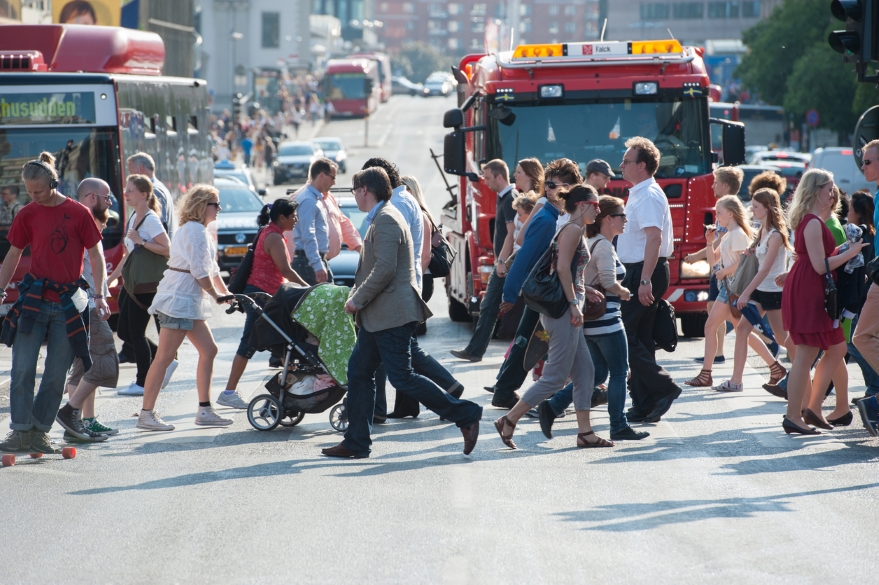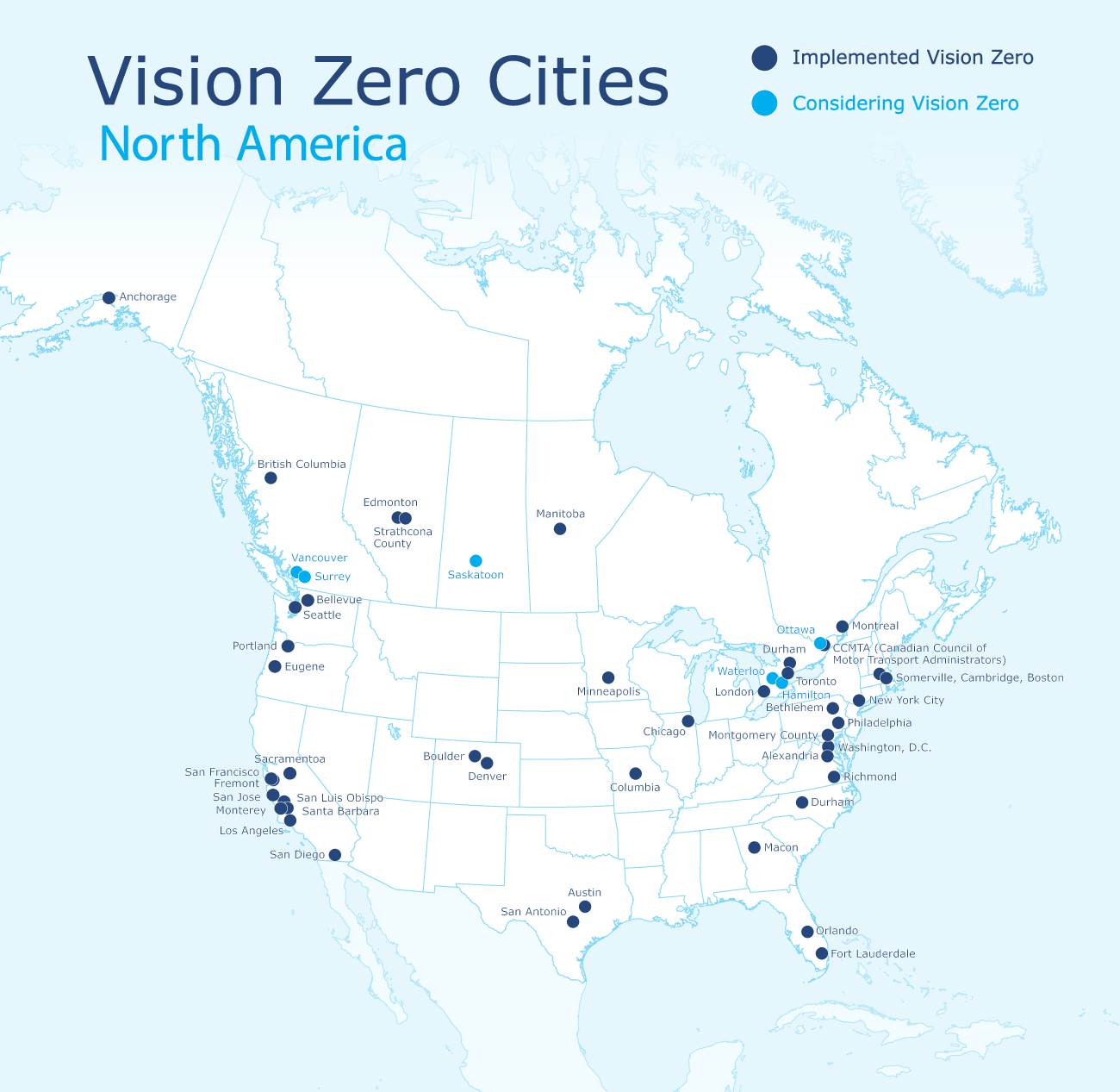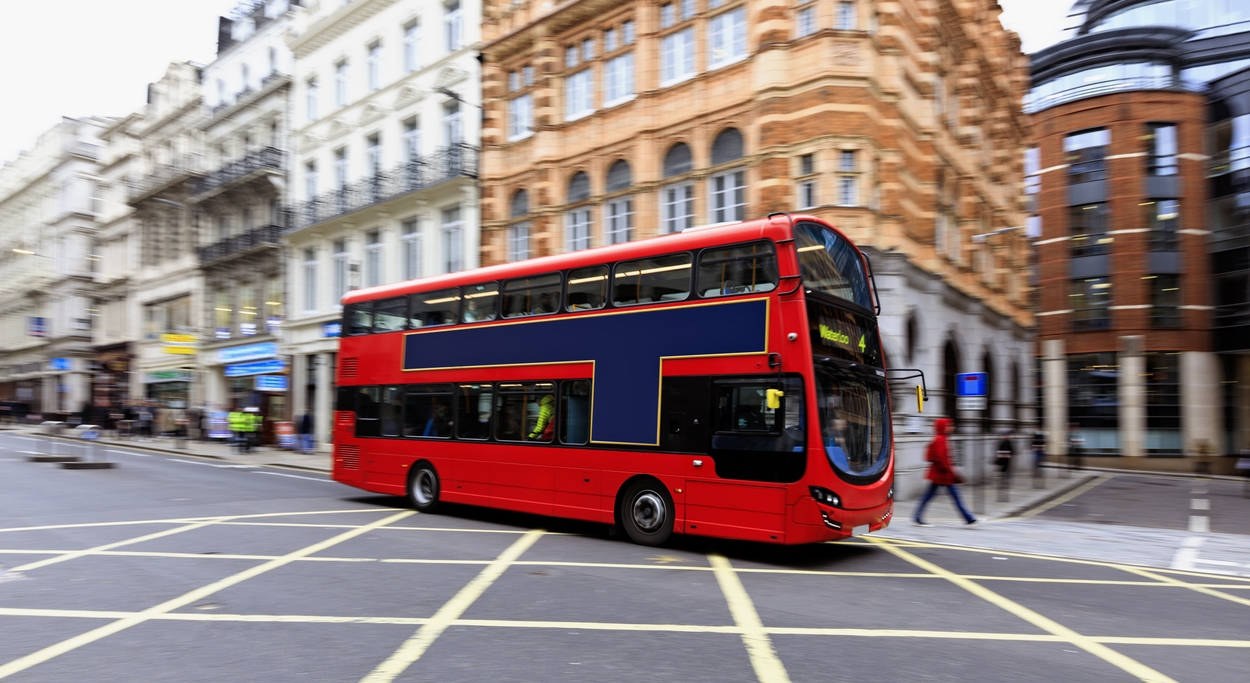Vision Zero: The road safety movement taking over the world
In 1997, Sweden passed a bill introducing Vision Zero into law. Now the Vision Zero network of cities is expanding across the U.S. and beyond
By Geotab Team
Sep 26, 2018
Updated: Aug 26, 2024
4 minute read

One million people die in traffic-related incidents around the world every year. By 2030, that number is expected to rise making road traffic fatalities the fifth leading cause of death worldwide. Vision Zero is an initiative created to prevent collisions and give citizens the right to safe mobility.
Now a global movement for safety, Vision Zero is focused on an ambitious goal: achieving zero road fatalities. The Vision Zero initiative sums this up on their website with these words: “No loss of life is acceptable.”
See also:
How cities are using telematics to achieve their Vision Zero safety objectives
What is Vision Zero?
It all started in 1997, when the government of Sweden passed a Traffic Safety Bill that officially introduced Vision Zero into law. The initiative aims to view collisions as preventable with the help of a data-driven and targeted approach. Based on ethics, the founders believe no one should be injured or killed by a road collision, and whereas humans can make mistakes, the road system should be designed for efficiency and safety.
Safety is a shared responsibility
Vision Zero aims to educate citizens and advocate that responsibility for safety is shared not only between those who use the road transport system, but also those who design it. The system designers, police, road managers, the automotive industry, legislative bodies and politicians are all obligated to support safety and help ensure all components in the transport system are functioning well together.

City street in Stockholm, Sweden.
How are Vision Zero cities different from other cities?
To become a part of Vision Zero, a city must meet the following requirements:
- The mayor has committed to Vision Zero on a public platform.
- A strategy and Vision Zero plan has been put in place.
- A goal of eliminating severe injuries and traffic fatalities has been set.
- Public health, transportation, police and other significant city departments are committed.
The main areas of focus for Vision Zero cities include: reducing impaired driving; enhancing pedestrian and cyclist safety; introducing safer car design; improving road infrastructure; increasing the use of seat belts; and implementing safer speed limits.
The cities partnered with Vision Zero are working toward enhanced regulations in the city, advocating for policy change, educating residents and policy makers regarding dangers of risk factors and analyzing road infrastructure for changes.
From Saskatoon to San Francisco and beyond: List of Vision Zero cities
What started with a small town in Sweden has now become a global phenomenon. In the U.S, Vision Zero began with 10 early adopter cities which laid the foundation. Boston, Chicago, Washington, Seattle, San Francisco, Portland, New York, Fort Lauderdale, San Diego and Los Angeles were chosen as the focus cities through a competitive process to accelerate Vision Zero in the United States. Through leadership development and peer-to-peer networking, the U.S. Vision Zero Network is advancing the cause of road safety across the country.
In Canada, the cities of Toronto, Edmonton, Vancouver, Ottawa, London and Montreal have implemented Vision Zero road safety strategies. This month, Saskatoon, Saskatchewan adopted the Vision Zero principle.

Map of Vision Zero Cities in North America (already implemented and considering).
Cities with a vision: Aiming for zero road fatalities and beyond
New York City: With millions of tourists visiting the “Big Apple” and heavy pedestrian traffic all year around, New York City is one of the busiest cities in the world. Every two hours, a resident of New York City is injured or killed by a vehicle.
To reduce the number of fatalities in its city, New York is committed to Vision Zero and has expanded enforcement against failing to yield to pedestrians and speeding. They are also working on updating street designs to improve safety in every borough and increasing the use of speed cameras. New York has credited Vision Zero for the 27 percent drop in traffic fatalities since 2014, however, the city’s main goal is to reduce that number to 50 percent by 2025.
Los Angeles: In 2017, 245 people lost their lives to traffic-related incidents. Due to the high number of severe and fatal collisions involving pedestrians and cyclists, the city has began to focus on protecting citizens, especially children and seniors. To improve safety, they have implemented speed feedback signs, pedestrian paddle signs and pedestrian refuge islands. By 2025, Los Angeles aims to eliminate all serious injuries and traffic deaths.
Portland: Like Los Angeles, the city of Portland, Oregon is focused on “eliminating all traffic deaths and serious injuries by 2025” as published in the letter from Commissioner Steve Novick. In January 2018, Portland rolled out a 20 mph speed limit in residential areas to curb speeding on its network of narrow streets.
The city also installed speed safety cameras at its most dangerous intersections to assist Police in combating speeders. Representatives from a broad range of organizations and community groups have come together to work on the Vision Zero Task Force, including TriMet transportation services, Portland Police Bureau, Oregon Trucking Association, AAA and AARP.
Toronto: As a part of Vision Zero’s road safety plan, Toronto has announced an expansion program to permit pedestrians a headstart when crossing the road. Allowing pedestrians, including children and seniors to cross first so they are more visible to drivers will improve safety and decrease collisions. The city of Toronto is also seeking an additional $13 million dollars in 2018 to spend on road redesigns, installing speed-humps, expanding leading pedestrian interval signs, adding zebra markings at 200 new intersections and painting green bike lanes.
Read more about Geotab's fleet safety management solutions.
London: Transport for London (tfL), the mayor, and the Metropolitan Police Service have set out London’s first Vision Zero initiative which includes lower speed limits, tougher safety standards for the design of trucks and a new bus safety program. The city of London is planning to achieve the Vision Zero target by 2041.

London’s bus safety program includes Autonomous Emergency Braking Systems and alerts for pedestrians.
Imagining a future beyond zero
In the country where it all began, Sweden has a zero tolerance policy for road collisions. All roads are built with safety prioritized over convenience or speed which includes having more roundabouts, fewer intersections and strict restrictions for vehicles not being allowed to turn where pedestrians are crossing the street.
Sweden continues to provide leadership in the area of road safety with a new addition of the #MovingBeyondZero campaign led by The Swedish Traffic Safety Council for Active and Sustainable Mobility. The initiative aims to promote and encourage transport decision makers and traffic planners to go beyond what Vision Zero has promoted for the last two decades and factor in the countless health benefits of active transport including cycling, walking and public transport. The encouragement of active transport is aimed to improve cities by reducing the amount of cars on the road, which in turn, will decrease collisions.
Geotab and Vision Zero
Although many countries have began working together to promote the goal of zero road-related incidents and deaths, we still have a long way to go. Geotab is a proud sponsor of the Vision Zero Network and through these partnerships, Geotab gains opportunities to provide actionable insights to municipalities across the United States who are dedicated to reducing injuries, traffic fatalities and enhancing safety.
For more fleet safety news, please subscribe to the Geotab Blog.
Related:
Improving road safety with technology innovation
Subscribe to get industry tips and insights
Geotab Team
The Geotab Team write about company news.
Table of Contents
Subscribe to get industry tips and insights
Related posts

The fleet safety incentive program checklist for driver engagement that lasts
June 19, 2025
2 minute read

Building a self-sustaining school bus driver safety program with Geotab Vitality
June 13, 2025
7 minute read

55+ Surprising distracted driving statistics and facts for 2025
May 30, 2025
8 minute read

Smart selection guide for school bus fleet maintenance features
May 21, 2025
5 minute read

Driving the Future of Public Safety: My Experience at Axon Week 2025
May 21, 2025
2 minute read
